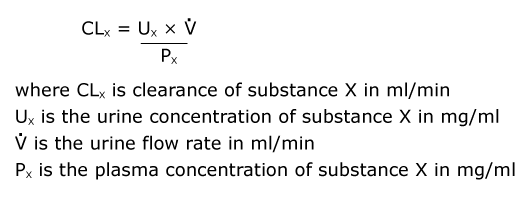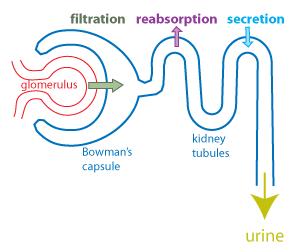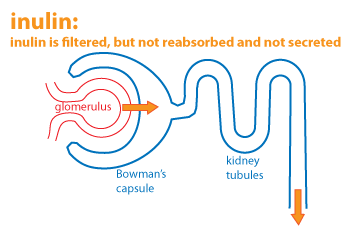
A 54-year-old woman with an 11-year history of type 2 diabetes presented for care. Her blood pressure (BP) was 155/90 mm Hg, and the glycated hemoglobin level was 7.6 mg per deciliter. The medications she was taking include:
Metformin is a drug that is used to control hyperglycemia in type
2 diabetics. Statin drugs inhibit a key enzyme in cholesterol
synthesis causing a decrease in LDL cholesterol, which decreases
the risk for cardiovascular disease. The ACE inhibitor and the
thiazide diuretic are two drugs that treat high blood pressure.
What does "ACE" stand for?
What is the signaling molecule whose level is reduced through treatment with an ACE inhibitor?
What does a diuretic do?
She was first noted to have proteinuria 4 years earlier; her serum creatinine level then was 1.1 mg per deciliter. A 24-hour urine collection was performed and analyzed. Her urinary protein excretion was 2.8 g per 24 hours. At the time of presentation, her serum creatinine level was 2.1 mg per deciliter.
Proteinuria means protein in the urine. Normally, proteins are not filtered because they are too large to pass through the filtration membrane. Proteinuria is a sign of kidney disease. A sign is something that can be discovered or measured in an examination, as opposed to a symptom, which is a change that the patient experiences as a consequence of a disease.
What specific part of the nephron is damaged to cause protein to appear in the urine?
The second factor that is being monitored in this patient is serum creatinine. This is a
measure of the concentration of creatinine in the blood.
Creatinine is a metabolic breakdown product of creatine, which is
found in skeletal muscle. Normally, small amounts of
creatine are converted to creatinine and slowly released to the
blood. The concentration of creatinine in the blood depends
upon how fast it is removed by the kidneys.
Does the patient's increasing serum creatinine indicate that her kidney function is deteriorating or improving?
The increasing proteinuria and serum creatinine measures indicate
that this patient has kidney disease. An important measure
of kidney function is the glomerular
filtration rate (GFR).
The
GFR is the rate at which fluid leaves
the glomerular capillaries and enters Bowman's space.
The
measured GFR is the sum of the single nephron glomerular
filtration rate for all the functioning nephrons in both
kidneys. If a disease process is causing damage and loss of
nephrons, this will cause a decline in the GFR.
The average GFR in a healthy young adult is 100 ml/min. GFR
varies according to sex and also is usually normalized to body
surface area to account for individuals of different sizes.
This patient who has diabetes and proteinuria has diabetic nephropathy, the most
common form of chronic kidney disease.
Chronic
kidney disease occurs when some process causes steady damage to
the kidney over the course of years. Chronic kidney disease
is diagnosed when GFR falls below 60 ml/min.
There are different techniques for determining GFR, but we want to focus on the method that makes use of the concept of renal clearance. Renal clearance is the rate at which a substance is removed from the blood plasma by the kidneys. Renal clearance is defined as the volume of plasma that is cleared of a substance by the kidneys per unit time. The formula for clearance is:

Note that the numerator of the clearance formula, urine concentration (mg/ml) times urine flow (volume in ml/min) yields the amount excreted (technically rate of excretion in mg/min).

To determine the volume of plasma "cleared" per unit time, we divide this number by the plasma concentration. Another way of thinking about clearance is to recognize that the amount excreted is equal to the plasma concentration times the volume of plasma cleared.

Renal clearance treats the situation as though the kidneys are
totally removing a substance from discrete volumes of
plasma. That isn't really the way the kidneys work;
nevertheless, clearance is a useful concept.
GFR can be directly measured by measuring the renal clearance of inulin. Inulin is a plant carbohydrate, and so it must be injected into the body. Inulin is used to measure clearance because of two key properties:
To understand why the clearance of inulin is equal to the glomerular filtration rate, we need to understand how substances get into the urine so that they are excreted. This requires a review of the processes that occur in the kidney, which are shown in the figure of a diagrammatic nephron below.

The first step in urine formation is filtration, in which about a fifth of the plasma that flows into the glomerular capillaries moves across the filtration membrane and into Bowman's space. This filtrate then flows through the renal tubule where substances may be transferred from the forming urine back into the extracellular fluid (reabsorption) or substances may be transferred from the extracellular fluid into the forming urine (secretion). The amount of a substance that ends up in the urine is just the sum of these three processes: the amount filtered, plus any amount secreted, minus any amount reabsorbed.

 In the case of
inulin, there is no reabsorption and no secretion. The only way
that inulin gets into the urine is by filtration. Thus the volume
of urine cleared of inulin is the same as the volume that was
filtered. In other words, the clearance of inulin is the
glomerular filtration rate (GFR).
In the case of
inulin, there is no reabsorption and no secretion. The only way
that inulin gets into the urine is by filtration. Thus the volume
of urine cleared of inulin is the same as the volume that was
filtered. In other words, the clearance of inulin is the
glomerular filtration rate (GFR).
Glucose is a molecule that is filtered and then 100% reabsorbed. What do you think the clearance of glucose is?
The patient was enrolled in a clinical trial in which inulin clearance was determined. Inulin was injected and then the following measurements were made:
What is the renal clearance of inulin?
What is the GFR?
Because inulin needs to be injected, inulin clearance is not routinely measured. Instead, clinicians monitor creatinine and determine creatinine clearance.
The 24-hour urine collection that the patient had done was used to determine creatinine clearance. The following measurements were made:
What is the renal clearance of creatinine?
This calculation requires us to do some conversions. Note that the plasma creatinine concentration is given in mg/dL, which we need to convert to mg/ml. A deciliter (dL) is equal to 100ml. As well, the urine flow rate needs to be converted from ml/24hr to ml/min. Whenever you are doing calculations such as this, always be sure to follow the units. If you make the calculation correctly, the units should work out.
Creatinine clearance is greater than inulin clearance. What does this tell you about the way that the kidney handles creatinine?
Next we will determine how much creatinine was secreted.
Recall that the amount excreted (amount in the urine) will be the
sum of the renal processes:

To determine the amount secreted, we must first determine the amount of creatinine filtered (the filtered load).The filtered load is equal to the rate at which fluid flows into Bowman's space (the GFR), multiplied by the concentration of creatinine in Bowman's space. Since filtration is just bulk flow of water and small molecules into Bowman's space, then the concentration in Bowman's space is the same as the plasma concentration. Thus, the equation for determining filtered load is:

The amount secreted will just be the difference between the filtered load and the amount excreted in the urine.
What is the filtered load?
How much creatinine is secreted?
 Because only a small
amount of creatinine is secreted, creatinine
clearance can be used as a rough estimate of GFR
and a way to gauge kidney function. In routine screening for
kidney function, estimated GFR (eGFR) is
calculated using a serum creatinine measurement
plugged into various equations. These equations were developed
from data in which both GFR and serum creatinine were measured in
many patients and correlated mathematically, while adjusting for
factors such as age, sex, and body weight of the patient.
Because only a small
amount of creatinine is secreted, creatinine
clearance can be used as a rough estimate of GFR
and a way to gauge kidney function. In routine screening for
kidney function, estimated GFR (eGFR) is
calculated using a serum creatinine measurement
plugged into various equations. These equations were developed
from data in which both GFR and serum creatinine were measured in
many patients and correlated mathematically, while adjusting for
factors such as age, sex, and body weight of the patient.
Older eGFR formulas included an adjustment for Black race.
The inclusion of race in eGFR formulas was problematic because
race is not a biological determinant in the way that age and sex
are. Furthermore there is a large variability among
individuals identifying as Black. The National Kidney
Foundation and the American Society for Nephrology have
re-evaluated the use of race in these equations and issued a
recommendation in September 2021 to use a race-free method for
estimating GFR. Due to the efforts of a group of UW medical
students, UW Medicine began using a formula for eGFR that is not
adjusted by race in June 2020. You can read more about that
change here.
In class during the week of November 18, we will do the
calculations for the questions posed in the pink boxes. On
Quiz Section Test 5, there will be several calculation problems
similar to the ones above. To prepare for the final quiz
section test, you should:
This file provides some additional practice problems. Please note that although the practice problems may be multi-part questions, questions on the quiz section test will be limited to a single calculation.